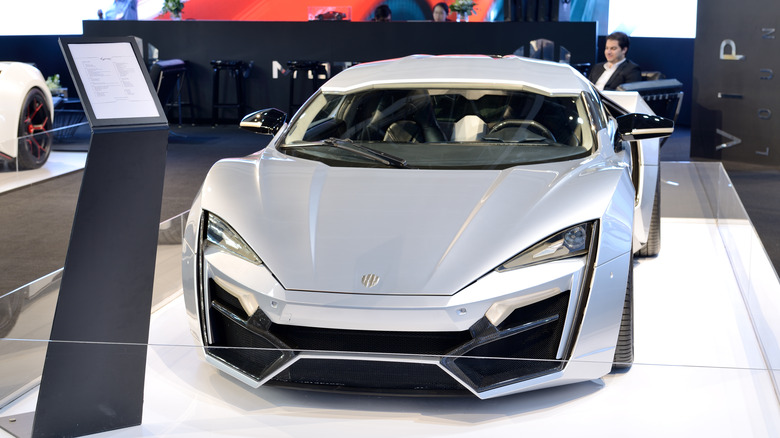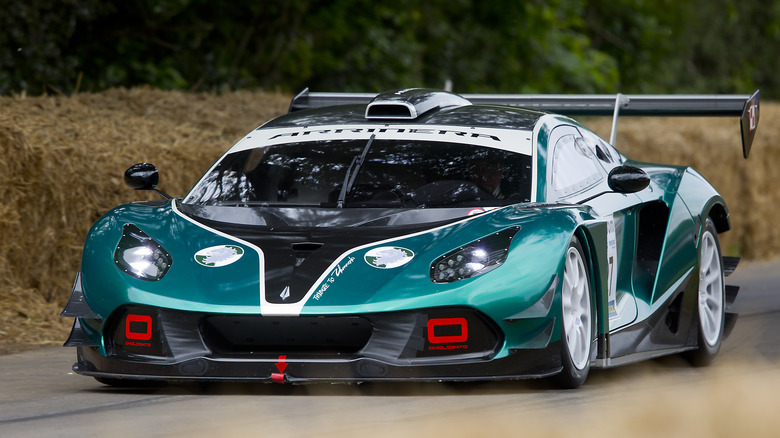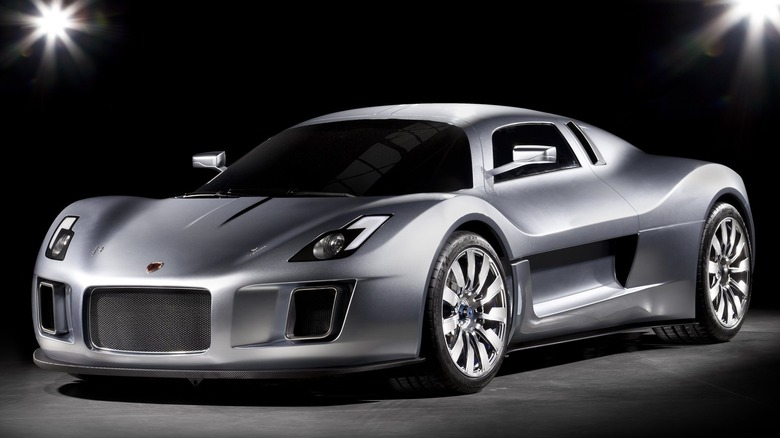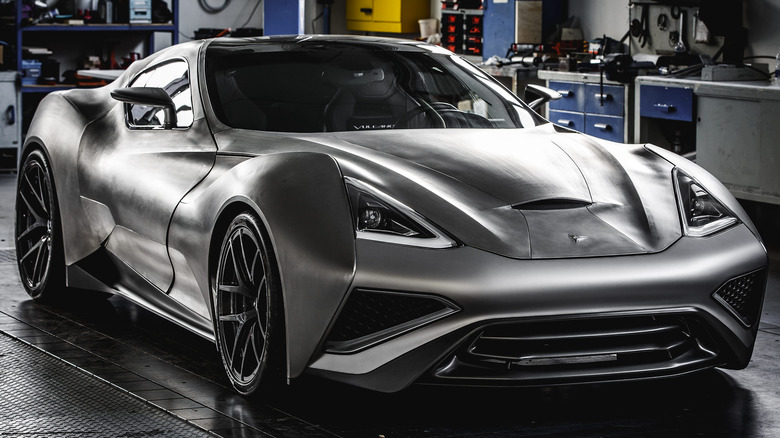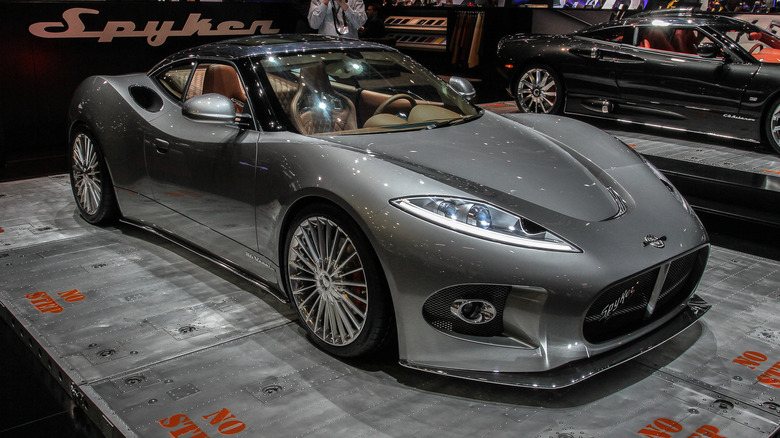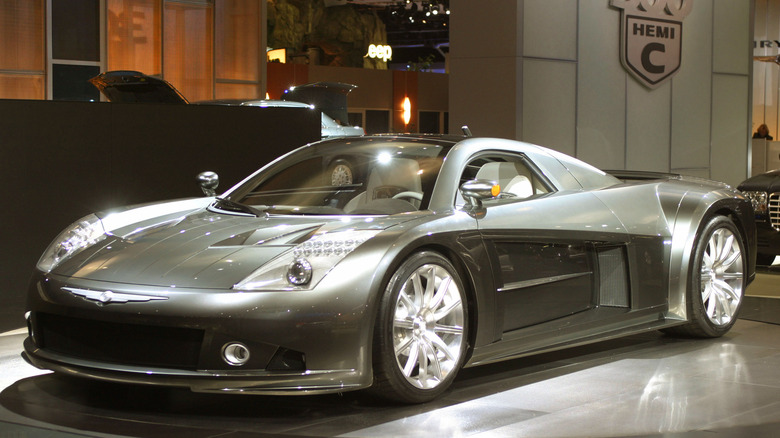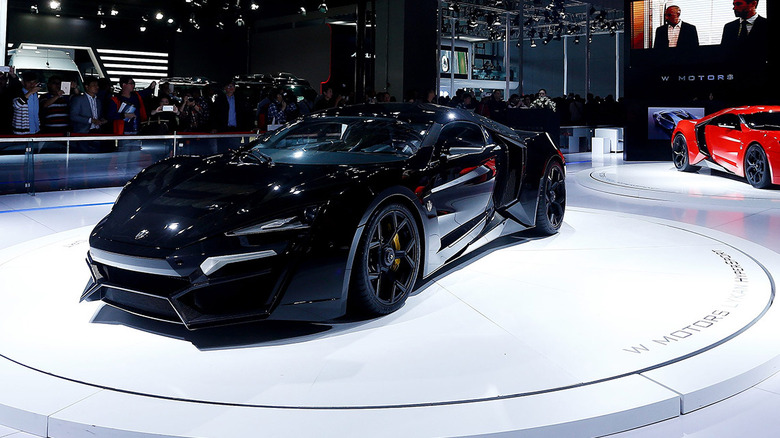10 Obscure Supercars That Disappeared Before Production
Supercars in their true form have been around since the late 1960s, after the Lamborghini Miura and its mid-engine layout announced a paradigm shift for production performance vehicles. Supercars represent the absolute peak for a lot of automakers' lineups, and for some of them, that's all that they offer.
Due to the incredibly high level of engineering and precision required to build the world's best supercars, it should come as a surprise to no one that they're very expensive to develop and manufacture. While some automakers are able to secure funding — whether that's thanks to a larger automotive group that owns them or because of other investment sources — plenty throughout history have been simply unable to.
While they did show the world proof of concept for their time-bending, world-challenging supercars, these automakers couldn't make it past the concept and development stage for one reason or another, and we never got a production version of any of these supercars.
Savage Rivale Roadyacht GTS
When building and designing a supercar, there are some things that will be sacrificed. Practicality, ride quality, usability, a lot of that stuff simply isn't very high on the priority list for supercar manufacturers. Netherlands-based Savage Rivale had a vision of how that could change. A bizarre, no-holds-barred vision.
The Roadyacht GTS looks like a fairly standard mid-engine supercar at first glance, with some minor resemblance to the equally elusive Spania GTA Spano. However, a closer look shows that the Roadyacht GTS is unlike any supercar we've seen before.
For one, it has four doors, which likely goes against a lot of the established rules of what a supercar should be. All four of the doors use a butterfly mechanism, but the rears are hinged backwards. Oh, and it's also a convertible with a folding hardtop with power comes from — what else – a supercharged LS V8. Obviously, the Roadyacht GTS never came to fruition, and we're not sure who might have bought one anyway. The closest most enthusiasts can get to driving it is through "Asphalt 8 Airborne" on mobile devices.
[Featured image by Alexandre Prévot via Wikimedia Commons | Cropped and scaled | CC BY-SA 2.0]
Arrinera Hussarya
That name leaves quite a first impression, doesn't it? The Arrinera Hussarya was supposed to be the first supercar designed and engineered in Poland, and on paper, it seemed very promising. It's similar to the Noble M600, in the sense that while the body would be made from all sorts of lightweight composite materials, the chassis would be made of high-strength steel.
A 6.2-liter GM Small Block would deliver 650 hp to the rear wheels through an automated-manual transmission from Italian supplier CIMA, who also built the gearbox for that obscure Italian supercar called the Pagani Zonda. So obscure, in fact, that the company behind it can't seem to stop building it.
Arrinera had big plans for the Hussarya, with hopes of a motorsport career for its magnum opus, but due to a lack of funding, the company never managed to get a single production car out on the road, or even to owners' hands. If you want to try it for yourself, you'll have to refer to "Asphalt 8 Airborne" once again.
Gumpert Tornante
The brainchild of former Audi engineer Roland Gumpert, the Gumpert Tornante set out to change the fabric of the supercar world, like most of these companies did. This time, however, the man behind it actually had something to brag about — the Audi WRC team was under his jurisdiction during the early '80s, when it raked in tons of victories.
After the track-focused, function-over-form Gumpert Apollo set the supercar world on fire for a brief minute, Gumpert Sportwagenmanufaktur was readying up its next supercar project. The Tornante was revealed in 2011, and it was the German manufacturer's idea of a luxurious mid-engine supercar.
Carrozzeria Touring Superleggera, who also gave us the Alfa Romeo Disco Volante, was responsible for the surprisingly gorgeous exterior styling. The powertrain, meanwhile, was a twin-turbo Audi-sourced V8 in a very similar state of tune as the Apollo S, putting out a pretty major 700 hp. Sadly, Gumpert Automobile went bankrupt back in 2013, leaving the Tornante project in limbo. The good news is, from the ashes of Gumpert Sportwagenmanufaktur rose Apollo, and that seems to be doing pretty well.
Dagger GT
So far, most of the specifications of these supercars have been fairly believable — one might even call them impressive. The Transtar Dagger GT's specs are also very impressive, but they also look like a 12-year-old wrote them. The other supercars on this list make us feel with the passionate teams behind them, but we're finding it tough to take this one seriously.
The furthest the Dagger GT seems to have gotten is a bunch of CG renders that were posted to the internet some 15 years ago. There don't seem to be any photos of even camouflaged prototypes being tested, let alone a scale model or even a working uncamouflaged prototype.
Under the theoretical engine cover lay a theoretical V8 that could apparently take multiple kinds of fuel, with Transtar promising a one second 0-60 time and a top speed in excess of 300 mph. The company also took liberty in making insane claims that the car could achieve its top speed after one mile of full-throttle driving. In case it wasn't obvious, the Dagger GT did not end up taking home any of those records. After its short stint in the news, nobody ever heard of or even spoke about the Dagger GT again.
Icona Vulcano
Here's another awesome (on-paper) supercar that had a very sad end. When the Icona Vulcano was first revealed in the early 2010s, it featured striking exterior styling. The Italian brand also promised a V12 engine and full titanium bodywork. Not even Pagani's carbotanium composite could match that at the time.
This one got a little bit further than most, as an actual working prototype was constructed and given to some journalists to drive. The bodywork was pure unpainted titanium, but instead of a V12, there was a small block Chevy V8.
Icona promised a top speed of 220 mph and a Nürburgring time of below seven minutes and 20 seconds. Normally, that would be pretty impressive, but for a price tag exceeding $2 million, you can't help but feel it needed more. Icona was, sadly, unable to secure the necessary funding, and we never got to see any customer Vulcano in the decade that passed.
Spyker B6 Venator
Dutch automaker (and former airplane maker) Spyker grabbed the supercar world's attention back in the early 2000s with the original C8 Spyder and Laviolette. With copious amounts of attention to detail and a heavy aviation theme — just take a look at the steering wheel – the original C8 definitely got some spotlights on it, and a few customer units were actually sold.
By the 2010s, however, Spyker had fallen into some financial dire straits, but it still wasn't ready to call it quits. By 2014, Spyker had introduced its answer to the Porsche 911: the gorgeous B6 Venator. The concept first debuted in coupe form, and then a striking red convertible also followed.
Like the C8, the B6 was mid-engined, and it was slated to use a turbocharged V6 from Audi, just as the C8 used a V8 from Audi. It was also smaller than the C8, and it had the Porsche 911 and Aston Martin V8 Vantage firmly in its sights. Due to the endless bankruptcy issues the automaker faced, however, the B6 Venator and the promised C8 Preliator that came a year or so later never happened. Considering how stunning the car was to look at, it's a huge shame that it never happened.
Chrysler ME-FOUR TWELVE
It's hard to believe, but at one point, Chrysler and Daimler AG, the parent company of Mercedes-Benz, were one. This resulted in stuff like the 300C being offered with a Mercedes diesel in foreign markets, and the hugely controversial SLK-based Chrysler Crossfire. For a little while, however, this partnership was supposed to bring the world the ultimate American supercar: the ME-FOUR TWELVE. Yes, in all caps.
Easily one of the most striking concept cars of the past 20 years, the ME-FOUR TWELVE was planned to be the ultimate patriotic supercar for the United States, essentially picking up the ball that Cadillac dropped with the Cien a couple of years prior. The dramatic exterior hid a Mercedes M120 6.0-liter V12 engine with four — count'em, four — turbochargers. For the record, a version of this engine also appeared in the Pagani Zonda.
With over 800 hp on tap, the ME-FOUR TWELVE could apparently reach 60 mph in 2.9 seconds and nudge 250 mph. That is, if you ever get traction, because it is RWD. While the project was almost greenlit for production, it never happened. Daimler was losing a lot of money on Chrysler and its sub-par products, and putting a car like this into even the smallest scale production would be way too expensive, so Daimler just didn't bother.
W Motors Lykan Hypersport
"Dom, cars don't fly!" That's what a panicked Brian O'Connor repeatedly yelled at a very determined Dominic Toretto during that iconic scene in "Furious 7," and then we saw the "$3.4 million" Lykan Hypersport jump across three different skyscrapers. A lot of people around the world were wondering, what is this mysterious supercar that completed such an epic stunt?
The W Motors Lykan Hypersport comes from the first automaker to be based in the U.A.E., specifically Dubai. The admittedly sharply styled bodywork hides a 780 hp flat six engine tuned by renowned Porsche tuners RUF, and the company also offered customers various extravagant cosmetic options like — and this is not a joke — diamond encrusted headlights.
Even though we've seen the Lykan multiple times in popular media like "Furious 7" alongside a multitude of video games, and even though W Motors even found time to design a second model, we have yet to see another customer vehicle. With almost a decade passing since its first appearance, people are starting to wonder — will the Lykan Hypersport ever reach proper production?
Dendrobium D-1
Quite the name this thing has. On paper, it's also quite the car, but the key phrase there is "on paper." The Dendrobium D-1 first debuted in concept form back in 2017, as Singapore's answer to the new wave of electric hypercars that were coming out. Rimac C_Two, which eventually became the Nevera, the Pininfarina Battista, the Aspark Owl, that sort of stuff.
Powering the D-1 is a quartet of electric motors — one for each individual wheel — with a total output in excess of 1,800 hp. The carbon fiber bodywork and battery housing would make it relatively lightweight, and the company promised that production would begin in 2022 for customer vehicles, with the old stalwart Williams Advanced Engineering being in charge.
Unfortunately, things soon got complicated and the Dendrobium D-1 is nowhere to be seen as of mid-2024. Luckily, the current crop of electric hypercars on offer certainly has no shortage of innovation or drama.
Devel Sixteen
Sure, you might say, nobody believed that Bugatti could pull off a road car with 1,000 hp and a top speed of over 250 mph. Then Bugatti went on to do just that, and those numbers don't even seem all that crazy nowadays. However, UAE-based automaker Devel's hypercar concept would make Albert Einstein's mustache curl upwards.
First shown in 2013 purely as a concept, the Sixteen promised — I hope you're sitting down for this – 5,000 hp from a V16 engine and a top speed of 348 mph. That's almost Mach 0.5, or half the speed of sound. People definitely raised a few eyebrows, and the theoretical possibility of such numbers was put into question.
Devel Motors actually did build a single working prototype of the Sixteen, although it didn't use a V16, rather a V8, most likely from General Motors. It's 2024, and so far, random internet videos of what Devel claims is a customer vehicle, and its prominent appearance in a Supercar Blondie video are all the proof we have that the Devel Sixteen exists. Frankly, we're not sure that the V16 version and all its 5,000 hp and Mach 0.5 speeds will ever happen, regardless of funding.
